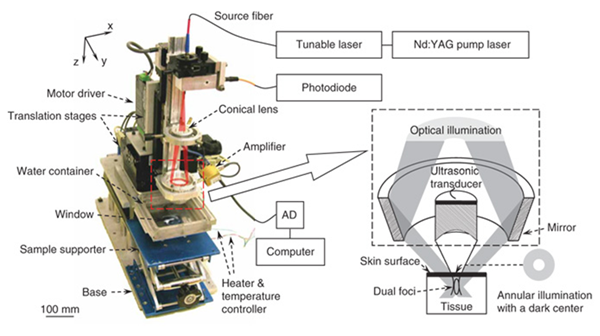By Frank Kuo
This post originally appeared on CLEO 2011 by Frank Kuo and is reproduced with permission from its author.
Shuffling among many eye-opening technical sessions and CLEO’s Market Focus & Technology Transfer Showcase, I simply realize adventures with light are everywhere:
An amazing imaging technique called photoacoustic imaging/microscopy (JTuG) caught my full attention on Tuesday. It is a perfect example of light collaborating with sound to achieve something fascinating. Think about it, light and sound are siblings. They are governed by similar natural laws. You might argue that light can propagate in vacuum while the sound needs media to do so. But again, they are siblings, not twins. So this argument does not really hold. Anyway, taking that into account, isn’t it fun to see them hold hands and work on something new together!?
The principle behind this new imaging technique is actually straightforward. The pulsed laser light (MHz repetition rates) is focused into the tissue; the tissue of interest absorbs the light and expands. This process is repeated with laser repetition rate. The pulsed expansion creates the ultrasonic sound wave, and we detect this by transducers. We then reconstruct the image of the tissue through some complex algorithm. We know that ultrasonic can penetrate deep tissue, while the resolution of ultrasonic is not as great as optical imaging. On the other hand, optical imaging can only go to a few millimeters deep. By endeavors of the researchers in improving this technique, photoacoustic imaging actually combines the strength of these two – it can do deep tissue imaging with optical imaging resolution – optical resolution photoacoustic microscopy.
 An experimental layout for photoacoustic microscopy.
An experimental layout for photoacoustic microscopy.
Fast-forward to Wednesday, a wonderful QELS session (QWB) focusing on laser cooling and its further applications on quantum computations and simulations are really hardcore stuffs. Using light to produce ultra cold molecules is definitely pushing the frontiers of science. We all heard of atoms cooled by lasers and a Nobel Prize was given to this achievement. But for molecules, things are more difficult. They have inertial structures and as a result, complicated processes are involved when cooling them by laser light. However, diatomic molecules are being cooled to sub micro Kevin through Sisyphus and Doppler cooling (check this article for more). If you missed today’s presentations, it is totally ok. On Thursday, sessions like QThJ,QThM, QThN, and QThO will feed your quantum hunger.
Talking about green energy, Laser Inertial Fusion Energy (LIFE) is discussed during CLEO’s Market Focus. Due to human mankind’s need in energy, we turn to fusion, and we intend to do so by using extremely high power lasers. LIFE utilizes 384 powerful lasers to create pulses with the energy of 3.1 mega Joule in IR and 2.2 mega Joule in UV per pulse. Each laser has the size of a truck and can be swapped in and out as a unit if the lifetime is reached or malfunction is found. This kind of gigantic project requires the state-of-art techniques and actually drives the development of the optical industry, such as glass productions. If you dig even further, the diode pumped helium cooled mercury amplifier inside each laser is just breathtaking. The helium is blown through the gain media with 0.1 Mach speed to cool down the laser. In other words, you even need aerospace technology to prevent the turbulence inside the laser.
Finally, also thanks to CLEO’s Market Focus & Technology Transfer Showcase, I just learned that an animated website created by JDSU called Photovoltaic for generating and measuring energy is a good starting point to know how light plays the role in green energy. Enjoy it and do not forget to check outCLEO’s Technology Transfer Showcase program tomorrow.
DISCLAIMER
The opinions expressed herein are those of the author and do not represent the Optical Society of America (OSA) or any OSA affiliate.
Posted: 4 May 2011 by
Frank Kuo
| with 0 comments